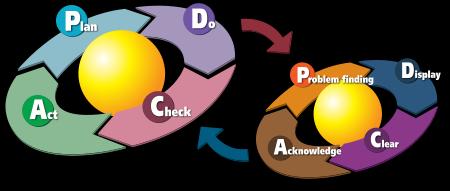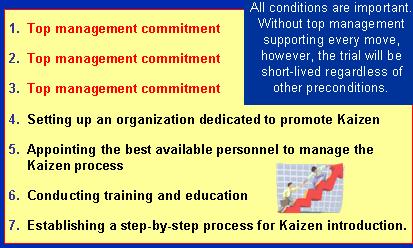 What is Kaizen?
What is Kaizen?
Kaizen means “improvement”. Kaizen strategy calls for never-ending efforts for improvement involving everyone in the organization – managers and workers alike. Kaizen activities involve everyone in a company – managers and workers – in a totally systemic and integrated effort toward improving performance at every level. It is to lead to increased customer satisfaction through satisfying such corporate cross-functional goals as quality, cost, scheduling, manpower development, and new product development.
In Japan, Total Quality Control (TQC) activities are not limited to quality control only. Elaborate system of Kaizen strategies has been developed as management tools within the TQC approach. TQC in Kaizen is a movement aimed at improvement of managerial performance at all levels.
According to the Japan Industrial Standards, “implementing quality control effectively necessitates the cooperation of all people in the company, including top management, managers, supervisors, and workers in all areas of corporate activities such as market research and development, product planning, design, preparation for production, purchasing, vendor management, manufacturing, inspection, sales and after-sale services, as well as financial control, personnel administration, and training & education. Quality control carried out in this manner is called company-wide quality control or total quality control (TQC).”
Quality control in Japan deals with quality of people. It is the fundamental concept of the Kaizen-style TQC. Building quality into its people brings a company a half-way towards producing quality products.
Kaizen and Management
Management has two major components:
1. maintenance, and
2. improvement.
The objective of the maintenance function is to maintain current technological, managerial, and operating standards. The improvement function is aimed at improving current standards.
Under the maintenance function, the management must first establish policies, rules, directives and standard operating procedures (SOPs) and then work towards ensuring that everybody follows SOP. The latter is achieved through a combination of discipline and human resource development measures.
Under the improvement function, management works continuously towards revising the current standards, once they have been mastered, and establishing higher ones. Improvement can be broken down between innovation and Kaizen. Innovation involves a drastic improvement in the existing process and requires large investments. Kaizen signifies small improvements as a result of coordinated continuous efforts by all employees.
Implementation of Kaizen Strategy: 7 Conditions

One of the most difficult aspects of introducing and implementing Kaizen strategy is assuring its continuity.
When a company introduces something new, such as quality circles, or total quality management (TQM), it experiences some initial success, but soon such success disappear like fireworks on summer night and after a while nothing is left, and management keeps looking for a new flavor of the month.
Process-Oriented Thinking vs. Result-Oriented Thinking
Kaizen concentrates at improving the process rather than at achieving certain results. Such managerial attitudes and process thinking make a major difference in how an organization masters change and achieves improvements.
Kaizen Mindset
Kaizen means “improvement”. Kaizen strategy calls for never-ending efforts for improvement involving everyone in the organization.
Kaizen Mindset is Kaizen’s Starting Point. It sets the right mindset and business environment in a Continuous Improvement Firm (CIF)
- Everything can and should be improved. (Some Japanese managers go as far as to say to their subordinates, “Regard whatever you do now as the ‘worst’ way to do your job.”)
- Not a single day should go by without some kind of improvement being made somewhere in the company.
- Don’t just criticize, suggest an improvement.
- Think beyond common sense. Challenge assumptions. Even if something is working, try to find the ways to make it work even better. Ask searching questions.
- Customer-driven strategy for improvement – any management activity should eventually lead to increased customer satisfaction.
Yin and Yang of Customer Value Creation
- Imagine the ideal customer experience and strive to provide it.
- Quality first, not profit first – an enterprise can prosper only if customers who purchase its products or services are satisfied.
- Recognize that any corporation has problems and establish a corporate culture where everyone can freely admit these problems and suggest improvement.
- Think of how to improve it instead of why it can’t be improved.
- See problem solving as cross-functional collaborative and systemic approach.
- Emphasis on process – establish a way of thinking oriented at improving processes, and a management system that supports and acknowledges people’s process-oriented efforts for improvement.
- Start with scarcity. It’s hard to see the need for Kaizen when resources are plentiful.
- When there is a worker or supplier performance problem, don’t replace them. Keep them and help them improve instead.
Kaizen and Lean Manufacturing
Kaizen is the heart of Lean Manufacturing (also known as the Toyota Production System). Toyota states: “…based on the concept of continuous improvement, or Kaizen, every Toyota team member is empowered with the ability to improve their work environment. This includes everything from quality and safety to the environment and productivity. Improvements and suggestions by team members are the cornerstone of Toyota’s success.”…
Employee Involvement and Empowerment: Toyota organized their workers by forming teams and gave them the responsibility and training to do many specialized tasks. Teams are also given responsibility for housekeeping and minor equipment repair. Each team has a leader who also works as one of them on the line.
Quality control (QC) circles can be viewed as a group-oriented suggestion system for making improvements. QC circle is a small group that voluntarily performs quality-control activities in the workplace.
Total quality control (TQC) involves everyone in the organization and is aimed at improvement of managerial performance at all levels.
According to Masaaki Imai, author of Kaizen: The Key To Japan’s Competitive Success, Japanese managers have more leeway in implementing employee suggestions that Western counterparts. Japanese managers are willing to go along with a change if it contributes to any of the seven goals of the suggestion system. This is a sharp contrast to the Western manager’s almost exclusive concern with the cost of the change and its economic payback.
7 Principles of Toyota Production System
- Reduced Setup Times: All setup practices are wasteful because they add no value and they tie up labor and equipment. By organizing procedures, using carts, and training workers to do their own setups, Toyota managed to slash setup times from months to hours and sometimes even minutes.
- Small-Lot Production: Producing things in large batches results in huge setup costs, high capital cost of high-speed dedicated machinery, larger inventories, extended lead times, and larger defect costs. Because Toyota has found the way to make setups short and inexpensive, it became possible for them to economically produce a variety of things in small quantities.
- Employee Involvement and Empowerment: Toyota organized their workers by forming team and gave them the responsibility and training to do many specialized tasks. Teams are also given responsibility for housekeeping and minor equipment repair. Each team has a leader who also works as one of them on the line.
- Quality at the Source: To eliminate product defects, they must be discovered and corrected as soon as possible. Since workers are at the best position to discover a defect and to immediately fix it, they are assigned this responsibility. If a defect cannot be readily fixed, any worker can halt the entire line by pulling a cord (called Jidoka).
- Equipment Maintenance: Toyota operators are assigned primary responsibility for basic maintenance since they are in the best position to defect signs of malfunctions. Maintenance specialists diagnose and fix only complex problems, improve the performance of equipment, and train workers in maintenance.
- Pull Production: To reduce inventory holding costs and lead times, Toyota developed the pull production method wherein the quantity of work performed at each stage of the process is dictated solely by demand for materials from the immediate next stage. The Kamban scheme coordinates the flow of small containers of materials between stages. This is where the term Just-in-Time (JIT) originated.
- Supplier Involvement: Toyota treats its suppliers as partners, as integral elements of Toyota Production System (TPS). Suppliers are trained in ways to reduce setup times, inventories, defects, machine breakdowns etc., and take responsibility to deliver their best possible parts.
Toyota Culture and Management Philosophy
The Toyota Way is not the Toyota Production System (TPS) . The 14 Principles of the Toyota Way is a management philosophy used by the Toyota corporation that includes TPS, also known as lean manufacturing. TPS is the most systematic and highly developed example of what the principles of the Toyota Way can accomplish. The Toyota Way consists of the foundational principles of the Toyota culture, which allows the TPS to function so effectively.
The Main Ideas of the Toyota Way
- To base management decisions on a “philosophical sense of purpose”
- To think long term
- To have a process for solving problems
- To add value to the organization by developing its people
- To recognize that continuously solving root problems drives organizational learning.
The 4 Sections and the 14 principles of the Toyota Way
I. Having a long-term philosophy that drives a long-term approach to building a learning organization
1. Base your management decisions on a long-term philosophy, even at the expense of short-term financial goals
II. The right process will produce the right results
2. Create a continuous process flow to bring problems to the surface
3. Use “pull” systems to avoid overproduction
4. Level out the workload (heijunka). (Work like the tortoise, not the hare)
5. Build a culture of stopping to fix problems, to get quality right the first time
6. Standardized tasks and processes are the foundation for continuous improvement and employee empowerment
7. Use visual control so no problems are hidden
8. Use only reliable, thoroughly tested technology that serves your people and processes
III. Add value to the organization by developing its people and partners
9. Grow leaders who thoroughly understand the work, live the philosophy, and teach it to others
10. Develop exceptional people and teams who follow your company’s philosophy
11. Respect your extended network of partners and suppliers by challenging them and helping them improve
IV. Continuously solving root problems to drive organizational learning
12. Go and see for yourself to thoroughly understand the situation (Genchi Genbutsu).
13. Make decisions slowly by consensus, thoroughly considering all options; implement decisions rapidly (Nemawashi).
14. Become a learning organization through relentless reflection (hansei) and continuous improvement (Kaizen).
Vũ Kiếm Minh [Combined documents & reports/Tài liệu tổng hợp]










































